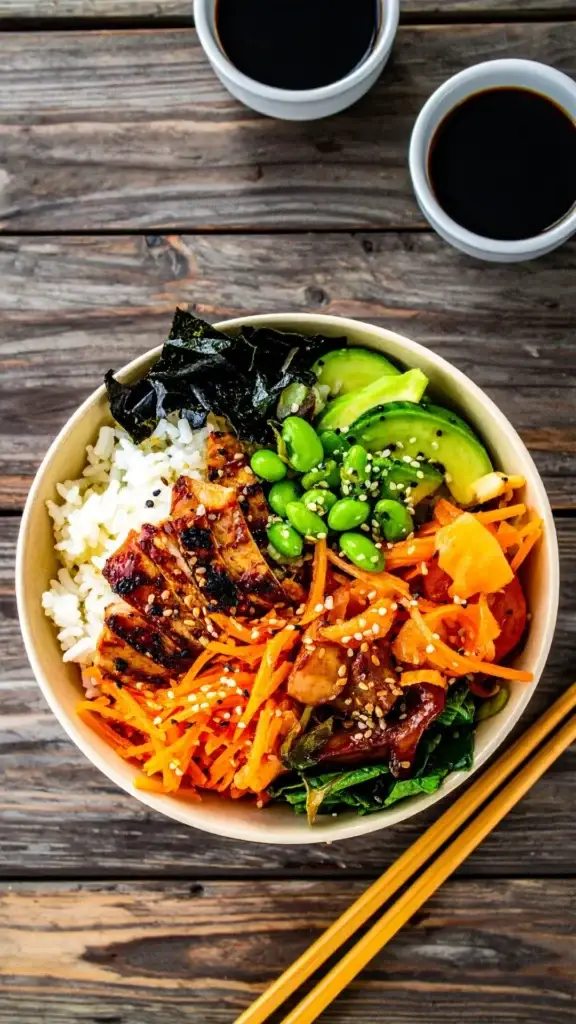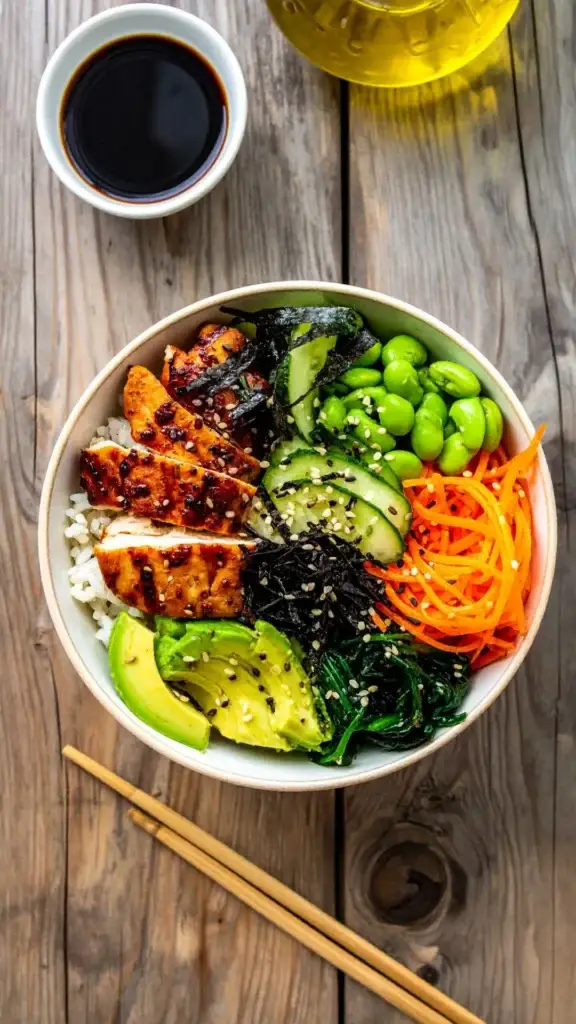Table of Contents
How to Make the Perfect Asian Bowls at Home: A Step-by-Step Guide
There’s a certain comfort that comes from a well-crafted bowl of rice, topped with vibrant vegetables, tender protein, and a drizzle of savory sauce. For many, Asian bowls are more than just a meal—they’re a celebration of flavor, a nod to tradition, and a canvas for creativity. Whether you’re longing for the warmth of a family recipe or eager to recreate your favorite restaurant dish, learning how to make the perfect Asian rice bowl at home can transform your kitchen into a place of culinary adventure. Let’s dive in and discover how you can bring the magic of Asian bowls to your own table.
What Makes Asian Bowls So Special?
They have a unique way of bringing together diverse flavors, textures, and colors in a single, satisfying dish. But what truly sets them apart?
Cultural Significance
Across Asia, rice bowls are a staple—each culture adding its own twist. In Japan, you’ll find donburi, a comforting bowl of rice topped with everything from simmered beef to tempura. In Korea, bibimbap brings together colorful veggies, savory beef, and a soft egg, all tossed with a kick of spicy gochujang. Chinese-style rice bowls often include melt-in-your-mouth pork belly, crisp stir-fried greens, or tangy sweet and sour chicken. Each bowl tells a story, connecting you to generations of tradition and innovation.
Balance of Flavors and Textures
What makes Them irresistible is their harmony. You get sweet, salty, sour, and umami in every bite. The crunch of fresh vegetables, the tenderness of perfectly cooked rice, and the richness of a well-seasoned protein all come together to create a meal that’s both satisfying and exciting.
Customizability
One of the best things about Asian bowls is how easily you can make them your own. Whether you’re vegetarian, gluten-free, or just looking to use up what’s in your fridge, you can tailor every element to suit your taste and dietary needs.


Essential Ingredients for the Perfect Asian Rice Bowl
Before you start building your bowl, it’s important to understand the key components that make Asian bowls so delicious. Let’s break down the essentials.
Choosing the Right Rice for Asian Bowls
Rice is the foundation of any great Asian bowl. The type you choose will influence the texture and flavor of your dish.
- Jasmine Rice: Fragrant and slightly sticky, perfect for Thai-inspired bowls.
- Sushi Rice: Short-grain and sticky, ideal for Japanese donburi.
- Short-Grain White Rice: Common in Korean and Japanese cuisine.
- Brown Rice: Nutty and chewy, a healthier alternative.
- Cauliflower Rice: A low-carb option that still soaks up sauces beautifully.
Cooking Tips:
- Always rinse your rice until the water runs clear to remove excess starch.
- Use the right water-to-rice ratio (usually 1:1.25 for white rice, 1:2 for brown rice).
- A rice cooker ensures perfect results, but stovetop works well too—just keep the lid on and let it steam.
Proteins to Power Your Bowl
Protein adds substance and flavor to your Asian bowl. Here are some popular choices:
- Grilled Chicken: Marinate in soy sauce, garlic, and ginger for extra flavor.
- Beef: Thinly sliced and quickly stir-fried or simmered in a savory sauce.
- Tofu: Pressed and pan-seared for a crispy, plant-based option.
- Shrimp: Quick to cook and pairs well with spicy or tangy sauces.
- Pork Belly: Braised until tender, a favorite in Chinese rice bowls.
- Tempeh: A hearty, nutty alternative for vegans.
Marinades & Seasonings:
- Soy sauce, ginger, garlic, sesame oil, gochujang, miso, and rice vinegar are all excellent choices for marinating your protein.
Vibrant Vegetables and Toppings
Vegetables bring color, crunch, and nutrition to your bowl. Mix and match for variety:
- Cucumber: Cool and refreshing, sliced thin.
- Carrots: Julienned or shredded for sweetness and crunch.
- Edamame: Steamed and shelled for a protein boost.
- Bok Choy: Lightly sautéed or steamed.
- Mushrooms: Shiitake or cremini, sautéed for umami depth.
- Pickled Radish: Adds tang and a pop of color.
Crunchy Additions:
- Toasted sesame seeds, crispy shallots, nori strips, and chopped peanuts or cashews.
Sauces and Dressings for Asian Bowls
The right sauce ties everything together. Here are some favorites:
- Teriyaki Sauce: Sweet and savory, perfect for chicken or beef.
- Sriracha Mayo: Creamy with a spicy kick.
- Peanut Sauce: Rich and nutty, great for tofu or shrimp.
- Ponzu: Citrusy and light, ideal for fish or vegetables.
- Hoisin Sauce: Sweet and tangy, pairs well with pork or duck.
Homemade vs. Store-bought:
- Making your own sauces lets you control the ingredients and flavor, but high-quality store-bought options can save time.
Step-by-Step Guide: How to Make Asian Bowls at Home
Ready to build your own Asian rice bowl? Follow these steps for a foolproof meal every time.
Step 1 – Prepare the Rice
- Wash your selected rice under running water until the water runs clear.
- Prepare the rice in a rice cooker or on your stovetop, whichever you prefer. If you’re cooking on the stove, combine rice and water, let it come to a boil, then cover, lower the heat, and let it gently cook until all the water is gone.
- Fluff with a fork and keep warm.
Step 2 – Cook or Prep Your Protein
- Marinate your protein for at least 15 minutes (longer for deeper flavor).
- Grill, pan-sear, bake, or stir-fry until cooked through.
- Slice or cube as needed for easy eating.
Step 3 – Prep and Cook Vegetables
- Wash and slice all vegetables.
- For crunchy veggies like cucumber and carrot, serve raw.
- For heartier veggies like bok choy or mushrooms, quickly stir-fry or steam.
Step 4 – Assemble Your Asian Rice Bowl
- Layering Order: Start with a generous scoop of rice. Add your protein, then arrange vegetables around the bowl. Sprinkle on toppings and drizzle with your chosen sauce.
- Presentation Tips: Use a wide, shallow bowl. Arrange ingredients in sections for a beautiful, Instagram-worthy look.


Asian Rice Bowl Recipe Table
Use this simple guide as a starting point and feel free to make it your own:
| Ingredient | Quantity | Notes/Alternatives |
|---|---|---|
| Jasmine Rice | 1 cup | Or sushi rice, brown rice |
| Chicken Breast | 200g | Or tofu, beef, shrimp |
| Soy Sauce | 2 tbsp | Tamari for gluten-free |
| Carrot (julienned) | 1 | Substitute with daikon |
| Cucumber | ½ | Sliced thin |
| Edamame | ½ cup | Shelled, steamed |
| Sesame Oil | 1 tsp | For drizzling |
| Sriracha Mayo | 2 tbsp | Optional |
| Nori Strips | 1 sheet | Cut into thin strips |
| Sesame Seeds | 1 tsp | Toasted |
Instructions:
- Cook rice and keep warm.
- Marinate and cook protein.
- Prep vegetables and toppings.
- Assemble bowl as described above.
- Drizzle with sauce and enjoy!
Tips for Customizing Your Asian Bowls
Asian bowls are endlessly adaptable. Here’s how you can make them fit your lifestyle and cravings.
Dietary Adaptations
- Vegetarian/Vegan: Swap out meat for tofu, tempeh, or plant-based protein.
- Gluten-Free: Use tamari or coconut aminos instead of soy sauce. Double-check all sauces and marinades.
- Low-Carb: Substitute rice with cauliflower rice or shirataki rice.
Flavor Variations
- Japanese-Inspired: Add pickled ginger, wasabi, and teriyaki sauce. Top with a soft-boiled egg.
- Korean-Inspired: Use gochujang, kimchi, and a sunny-side-up egg. Add sautéed spinach and bean sprouts.
- Thai-Inspired: Include Thai basil, lime wedges, and a spicy peanut sauce. Top with chopped peanuts and fresh cilantro.
Common Mistakes to Avoid When Making Asian Bowls
Even the simplest dishes can go awry. Here’s how to sidestep the most common pitfalls:
- Overcooking or Undercooking Rice: Follow package instructions and don’t lift the lid while cooking.
- Using Too Much Sauce: A little goes a long way—too much can make your bowl soggy.
- Not Balancing Flavors: Taste as you go. Add a splash of vinegar or a pinch of sugar if needed.
- Skipping the Garnish: Toppings like sesame seeds, nori, and fresh herbs add essential texture and flavor.
Frequently Asked Questions About Asian Bowls
What is the best rice for Asian bowls?
Short-grain or medium-grain rice is usually best for Asian bowls because of its stickiness and ability to soak up sauces. Jasmine rice is great for Thai-inspired bowls, while sushi rice is perfect for Japanese donburi.
Can I meal prep Asian rice bowls?
Absolutely! Prepare your rice, protein, and vegetables ahead of time. Store each component separately in the fridge, and assemble your bowl when you’re ready to eat. This keeps everything fresh and prevents sogginess.
How do I make Asian bowls healthier?
Choose whole grain or cauliflower rice, add in lean options like chicken breast or tofu, and pile on a variety of fresh veggies. Go easy on high-sugar sauces and use healthy fats like sesame oil in moderation.
Are Asian bowls gluten-free?
They can be! Swap in tamari or coconut aminos for regular soy sauce, and always check your sauces and marinades to make sure they’re free from gluten.LAH.
What sauces go best with Asian bowls?
Teriyaki, sriracha mayo, peanut sauce, and ponzu are all excellent choices. Mix and match to find your favorite combination.
Conclusion
Mastering the art of the Asian rice bowl at home is both simple and rewarding. With a few staple ingredients and a willingness to experiment, you can create a meal that’s as nourishing as it is delicious. Whether you’re cooking for yourself, your family, or friends, Asian bowls offer endless possibilities for customization and creativity. So gather your ingredients, trust your taste buds, and start building your perfect bowl today.
If you found this guide helpful, share your own Asian bowl creations in the comments below or tag us on social media. Your kitchen is now your canvas—let your next meal be a masterpiece!
Ready to try your hand at Asian bowls? Bookmark this guide, experiment with new flavors, and make every meal an adventure. Happy cooking!
Have You Given This Recipe A Try?
There are no reviews yet. Be the first one to write one.

